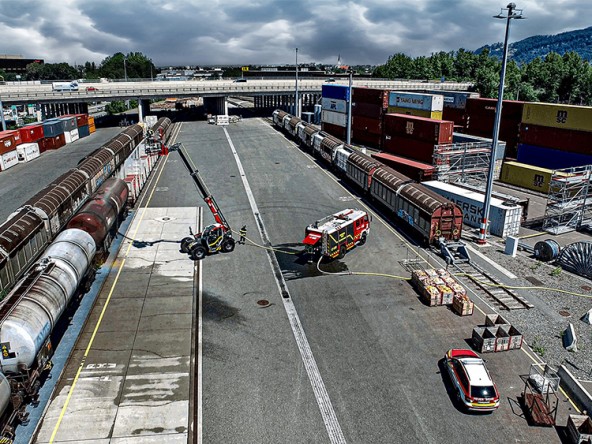The Liebherr Telescopic Handler - a critical multi-purpose vehicle for emergency services
The fire and emergency service of ÖBB Infrastruktur has to be on-call, at all times, to meet a very varied and often demanding set of operations. These range from emergency fire fighting and rescue incidents, in hard-to-reach places, to specialist support for infrastructure operations. And, when it really counts, the strengths of the Liebherr T 33-10s Telescopic Handler are really put to the test: the proven and simple to maintain design is easy to operate and ready to spring into action, at a moment’s notice, the excellent manoeuvrability will cross rough terrain with ease, and the safe and secure reach will stretch up to a working height of ten metres.

ÖBB - the Austrian Federal Railways – operates its freight centre and Combi Cargo Terminal at Wolfurt. Situated in the land triangle bound by Germany, Austria and Switzerland, it is a key logistics hub for handling goods between road and rail. The fire and emergency services of ÖBB Infrastruktur has been based there since 1985. To meet all potential emergencies, as well as specialist services, on this large industrial complex, the fire service is manned by 70 volunteer fire fighters, and is on-call at all times.

Ready for action at a moment’s notice, the fire service Liebherr telescopic handler is impressive: whether it is evacuating or recovering people from railway wagons, removing dangerous objects from overhead lines or tracks, quickly moving containers out of harm’s way, or transporting maintenance and recovery tools.
When we saw the versatility and ease of manoeuvrability, the added value of the telescopic handler made it an obvious choice. We can reach locations on the track with ease that is simply not possible with any other vehicle.
About the T 33-10s

What makes the Liebherr Telescopic Handler such a versatile and manoeuvrable vehicle, for emergency and recovery operations, comes down to a number of factors. Firstly, the combination of hydrostatic drive and four selectable steering modes allows for sensitive and precise control. Then, the high ground clearance and pivoting rear axle gives the telescopic handler a distinct advantage when traversing and crossing rail tracks safely. This is critical, because it allows equipment to be transported directly and swiftly to the rail track area. Accessibility with the vehicle is also highlighted, both by the tight turning radius, even with loaded jib, and by the lifting height and power, allowing hall roofs above the second floor to be reached with ease.

Julian Illigasch, Deputy Equipment Manager for ÖBB Infrastruktur fire services, is also quick to sing the praises of the T 33-10s. All-round cab visibility is excellent, not least when changing tools. But critically important is the intuitive machine control. Then, the alarm can go off at any time, and when it really counts, you have to be certain one of your team can operate the unit safely and securely.
The job
By clicking on “ACCEPT”, you consent to the data transmission to Google for this video pursuant to Art. 6 para. 1 point a GDPR. If you do not want to consent to each YouTube video individually in the future and want to be able to load them without this blocker, you can also select “Always accept YouTube videos” and thus also consent to the respectively associated data transmissions to Google for all other YouTube videos that you will access on our website in the future.
You can withdraw given consents at any time with effect for the future and thus prevent the further transmission of your data by deselecting the respective service under “Miscellaneous services (optional)” in the settings (later also accessible via the “Data protection settings” in the footer of our website).
For further information, please refer to our Data Protection Declaration and the Google Privacy Policy.*Google Ireland Limited, Gordon House, Barrow Street, Dublin 4, Ireland; parent company: Google LLC, 1600 Amphitheatre Parkway, Mountain View, CA 94043, USA** Note: The data transfer to the USA associated with the data transmission to Google takes place on the basis of the European Commission’s adequacy decision of 10 July 2023 (EU-U.S. Data Privacy Framework).




